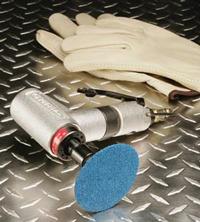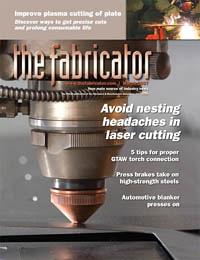- FMA
- The Fabricator
- FABTECH
- Canadian Metalworking
Categories
- Additive Manufacturing
- Aluminum Welding
- Arc Welding
- Assembly and Joining
- Automation and Robotics
- Bending and Forming
- Consumables
- Cutting and Weld Prep
- Electric Vehicles
- En Español
- Finishing
- Hydroforming
- Laser Cutting
- Laser Welding
- Machining
- Manufacturing Software
- Materials Handling
- Metals/Materials
- Oxyfuel Cutting
- Plasma Cutting
- Power Tools
- Punching and Other Holemaking
- Roll Forming
- Safety
- Sawing
- Shearing
- Shop Management
- Testing and Measuring
- Tube and Pipe Fabrication
- Tube and Pipe Production
- Waterjet Cutting
Industry Directory
Webcasts
Podcasts
FAB 40
Advertise
Subscribe
Account Login
Search
Easing the grind of cost reduction
Automotive supplier finds success with new disks for flash removal, deburring

Automotive parts supplier SPX CONTECH had struggled with quick-attach abrasive fiber disks for its flash removal and deburring of its die-cast aluminum parts. The company found a replacement disk that lasts three times longer than the problem disks.
The squeeze on companies in automotive supply chains to reduce their manufacturing costs is powerful. That means no stone is left unturned in search of cost savings.
SPX CONTECH® is one such automotive supplier. This producer of one-piece rack-and-pinion housings for Tier 1 companies is continuously looking for methods, processes, and products to reduce costs in an increasingly competitive marketplace. Even the smallest improvements can make big differences, especially considering the company's 110,000-square-foot Auburn, Ind., facility produces 4.5 million die-cast housings per year and ships more than 19 million pounds of aluminum annually.
In early 2005 SPX CONTECH decided to evaluate the abrasive disks used in its 22 die-casting cells. The abrasive disks are used to remove flash and deburr die-cast parts before they are shipped to customers.
By the end of that year, company officials had found that this small change led to improved productivity and cost savings because the disks lasted longer than the ones used previously.
Flash: Opportunity for Improvement
SPX CONTECH had been using quick-attach abrasive fiber disks for its flash removal and deburring processes. The disks, however, sometimes were cupping—no longer remaining flat—as a result of changes in moisture content. In some cases, the fiber disks would detach from the button.
The company approached 3M for help finding a disk that could tackle tough burrs without being too aggressive on the part finish, while also providing a surface finish that met customer specifications. It was important not to add production steps or increase costs with the answer.
More specifically, SPX CONTECH was looking for 3-inch abrasive disks for its flash removal and deburring processes that used right-angle die grinders to finish 2-foot by 3-in.-dia. aluminum die-cast parts. The disks had to hold up against the pressures associated with a high-volume manufacturing operation.
The company also wanted to see if the abrasive disks might eliminate excessive loading on the die-cast parts. Abrasive minerals that dull during grinding can cause premature loading because operators working with such less-than-optimal disks can apply excessive pressure while grinding. A mineral that retains its sharpness, theoretically, will cut faster and avoid the need to have operators apply excessive pressure.
An abrasive disk that would allow operators to work in difficult areas, such as corners, was another requirement. An abrasive with a backing that was flexible, yet stronger than a typical fiber or cloth backing, was a suitable choice.
Going With the Grain and a New Disk
SPX CONTECH historically used abrasives made with ceramic minerals. That led them to select 3M's Cubitron™ abrasive grain.

The new abrasive disks SPX CONTECH operators now use have an abrasive grain that is a proprietary ceramic aluminum oxide mineral that is designed to cut through metal quickly.
This abrasive grain is a proprietary ceramic aluminum oxide mineral that is designed to cut through metal quickly. As each abrasive grain fractures during usage, a fresh, sharp surface is exposed until the disk reaches the end of its useful life.
After evaluating several quick-release fiber disks through extensive testing, SPX CONTECH began using the 3M™ Roloc™ Disc 988R in November 2005. This quick-attach abrasive disk, which contains the Cubitron abrasive grain, is designed for weld removal, weld leveling, and deburring.
The disk contributed to a smoother run with better disk performance, according to Mike Schieber, the company's director of operations. The disks have a one-piece, nylon construction that is supposed to eliminate button delamination for better grinding balance and notably smoother running. The disks SPX CONTECH previously used produced some vibration because some of the buttons were slightly off-center.
"The button on the Roloc Disc 988R is precisely centered, providing better balance," said Pete Steinhagen, 3M Abrasive Systems Division marketing manager.
SPX CONTECH also found the abrasive disks to be more durable, even in corners.
"According to our records, we were able to use the same disk for up to three shifts when we were apreviously using several disks per shift, substantially improving operator productivity," Schieber said. "We're very happy that we are able to produce three times the number of parts per disk, while seeing better product quality."
In this case, easing the daily grind led to significant cost reductions.
No Stranger to New Technology
SPX CONTECH is a company that prides itself on embracing new technology.
"We're always on the lookout for the latest technologies that will help us provide competitive cost and quality to customers," said Mike Schieber, director of operations for the company's Auburn, Ind., facility.
P2000™ aluminum casting is one example. SPX CONTECH developed this proprietary die-casting process to create stronger aluminum components with the same efficiency it did using traditional high-pressure die casting (HPDC) to create parts. P2000 combines the advantages of HPDC—the abilities to achieve near net shape, deliver fast cycle times, and to work with a variety of alloys—with low-pressure casting, which produces die-cast parts that have minimal porosity, are solution heat-treatable, and have thick wall sections.
Currently the company is targeting axle, steering, and suspension system components for its aluminum casting technology.
subscribe now

The Fabricator is North America's leading magazine for the metal forming and fabricating industry. The magazine delivers the news, technical articles, and case histories that enable fabricators to do their jobs more efficiently. The Fabricator has served the industry since 1970.
start your free subscription- Stay connected from anywhere

Easily access valuable industry resources now with full access to the digital edition of The Fabricator.

Easily access valuable industry resources now with full access to the digital edition of The Welder.

Easily access valuable industry resources now with full access to the digital edition of The Tube and Pipe Journal.
- Podcasting
- Podcast:
- The Fabricator Podcast
- Published:
- 04/16/2024
- Running Time:
- 63:29
In this episode of The Fabricator Podcast, Caleb Chamberlain, co-founder and CEO of OSH Cut, discusses his company’s...
- Industry Events
16th Annual Safety Conference
- April 30 - May 1, 2024
- Elgin,
Pipe and Tube Conference
- May 21 - 22, 2024
- Omaha, NE
World-Class Roll Forming Workshop
- June 5 - 6, 2024
- Louisville, KY
Advanced Laser Application Workshop
- June 25 - 27, 2024
- Novi, MI































